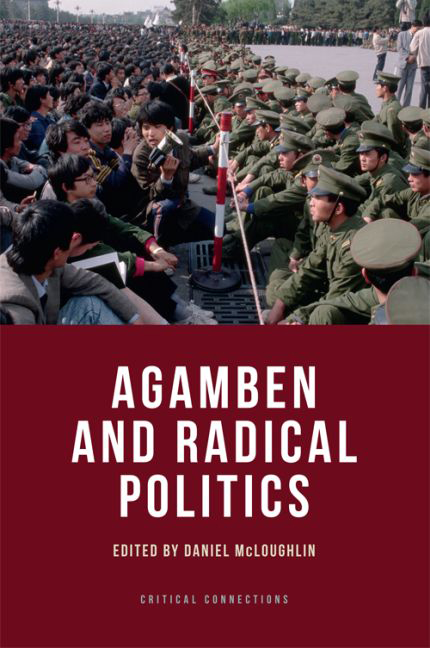Book contents
- Frontmatter
- Contents
- Acknowledgements
- Introduction: Agamben and Radical Politics
- 1 Capitalism as Religion
- 2 Glory, Spectacle and Inoperativity: Agamben's Praxis of Theoria
- 3 On Property and the Philosophy of Poverty: Agamben and Anarchism
- 4 ‘Man Produces Universally’: Praxis and Production in Agamben and Marx
- 5 Liturgical Labour: Agamben on the Post-Fordist Spectacle
- 6 An Alogical Space of Genetic Reintrication: Notes on an Element of Giorgio Agamben's Method
- 7 Zoē aiōniōs: Giorgio Agamben and the Critique of Katechontic Time
- 8 Agamben, Badiou and Affirmative Biopolitics
- 9 Form-of-Life and Antagonism: On Homo Sacer and Operaismo
- 10 What Is a Form-of-Life?: Giorgio Agamben and the Practice of Poverty
- 11 Law and Life beyond Incorporation: Agamben, Highest Poverty and the Papal Legal Revolution
- Notes on Contributors
- Index
9 - Form-of-Life and Antagonism: On Homo Sacer and Operaismo
Published online by Cambridge University Press: 23 September 2017
- Frontmatter
- Contents
- Acknowledgements
- Introduction: Agamben and Radical Politics
- 1 Capitalism as Religion
- 2 Glory, Spectacle and Inoperativity: Agamben's Praxis of Theoria
- 3 On Property and the Philosophy of Poverty: Agamben and Anarchism
- 4 ‘Man Produces Universally’: Praxis and Production in Agamben and Marx
- 5 Liturgical Labour: Agamben on the Post-Fordist Spectacle
- 6 An Alogical Space of Genetic Reintrication: Notes on an Element of Giorgio Agamben's Method
- 7 Zoē aiōniōs: Giorgio Agamben and the Critique of Katechontic Time
- 8 Agamben, Badiou and Affirmative Biopolitics
- 9 Form-of-Life and Antagonism: On Homo Sacer and Operaismo
- 10 What Is a Form-of-Life?: Giorgio Agamben and the Practice of Poverty
- 11 Law and Life beyond Incorporation: Agamben, Highest Poverty and the Papal Legal Revolution
- Notes on Contributors
- Index
Summary
Before the publication in 2011 of his Altissima povertà. Regole monastiche e forme di vita, perhaps the most important concept in the work of Giorgio Agamben remained an enigma. The notion of a ‘form-of-life’ has been crucial for the conceptual system Agamben has slowly articulated since the first volume of his longrunning Homo Sacer project appeared in 1995. This concept, however, was nowhere developed in a thematic way, referred to only rarely and seemingly in passing. Yet a detailed examination of those instances where this term does appear would show that they are always placed at crucial sites, as if a final elucidation of the concept of form-of-life would resolve any lingering problems or questions that have emerged in the course of Agamben's politico-philosophical reflections on sovereignty and biopolitics.
The preface to The Highest Poverty underlines the central place of ‘form-of-life’ and its proximity to practice of ‘use’ and specifically a ‘use of bodies’: ‘to think a form-of-life, a human life entirely removed from the grasp of the law and a use of bodies and of the world that would never be substantiated into an appropriation’. The Franciscan conceptual strategy set out to define the possibility of a life or human activity emancipated from the structure and pressures of property and juridical title; a strategy that has, as its final horizon, a conception of usus pauper, ‘poor use’ – a technical term bringing together use and poverty – that would not be normed by a notion of law at all. Such a strategy, which was developed in a polemic against the Catholic curia, emphasised not only the distinction between use and law, but more specifically between use and usufruct, between a ‘free’ use of the world without law and a juridically ratified right to use this or that object, space, body or structure.
The crucial notion of ‘form-of-life’ returns once again in Agamben's most recent book, L'uso dei corpi (The Use of Bodies). While the book's ‘Prologue’ suggests that it will treat an entire series of concepts that have oriented the Homo Sacer project from the beginning – concepts such ‘use, exigency, mode, form-of-life, inoperativity, destituent power’ – it quickly becomes clear that ‘form-of-life’ has a privileged place in the book's conceptual architecture.
- Type
- Chapter
- Information
- Agamben and Radical Politics , pp. 189 - 206Publisher: Edinburgh University PressPrint publication year: 2016



